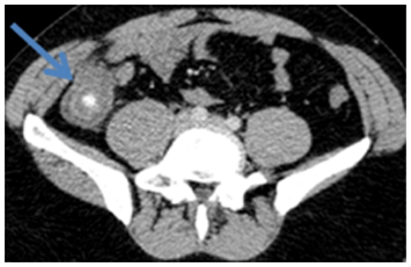Journal of
eISSN: 2373-633X


Case Report Volume 8 Issue 6
1Department of Radiology, Hospital Sao Camilo, Brazil
2Department Radiology, WEBIMAGEM, Brazil
Correspondence: Yehia Omar, PET/CT department at Misr Radiology Center, 8 khalifa mamoun, Heliopolis, Egypt, Tel 2.01001E+11
Received: August 04, 2017 | Published: November 7, 2017
Citation: Traple FAL, Dantas TN, Duarte ML, et al. Adult appendix cecal intussusception by lymphoid hyperplasia - A rare diagnosis. J Cancer Prev Curr Res. 2017;8(6):365-366. DOI: 10.15406/jcpcr.2017.08.00297
The appendix invagination on the adjacent portion of the lumen of the caecum characterizes the appendix cecal intussusception, which is a rare disease - incidence of 0.01% of the general population. It can occur at any age - most commonly in the first fifteen years of life. Affects mainly men (5: 1 ratio). The pain can mimic acute appendicitis. The patient can have a variable intensity of pain in the right iliac fossa, accompanied by vomiting for several days, with change the intestinal peristalsis - may progress to constipation, diarrhea and melena. The authors report a case with computed tomography diagnosis of this rare disease.
Keywords: abdominal pain/diagnosis, appendix/diagnostic imaging, intussusception/diagnosis; intussusception/diagnostic imaging, tomography, x-ray computed
Appendix cecal intussusception is the appendix invagination on the adjacent portion of the lumen of the caecum.1 It´s a rare disease, with an incidence of 0,01% of the general population,2 but can occur at any age, most commonly, in the first fifteen years of life, affecting mainly men (5:1 ratio).1 The etiology can be divided into anatomical and pathological causes.1
Anatomical causes:1
Pathological causes:1
Appendix tumors are uncommon and, most of them are benign.3 Appendix adenoma is a rare condition and adenocarcinoma is even rarer - most arises from an adenoma.3 Benign and malignant neoplasms have just reports associating them to appendix cecal intussusceptions.4 The evaluation of malignant and benign polyps, and mucosal and invasive lesions are extremely important for setting the treatment of choice.4 When there is a submucosally invasive cancer, it may have nodal involvement, and eradication of the affected colon and nodal dissection should be performed.4
26 years old man with moderate intensity colic pain in the right iliac fossa, radiating to the back for one day. Physical examination demonstrates flaccid abdomen, with no pain in the right iliac fossa decompression. Abdomen computed tomography (CT scan) with endovenous contrast shows "target" image in the appendix region, near caecum, compatible with appendix cecal intussusception to the caecum, marked thickening of the caecum and fine densification of adjacent fat, fecalith inside the caecum and lymph nodes in the right iliac fossa (Figures 1 & 2).

Figure 1 Abdominal CT Scan in axial section with endovenous contrast demonstrating appendix cecal inside the caecum, characterized the image in "multilamelar appearance" (blue arrow). There is an appendiceal inside the appendix. In association, we observed marked thickening of the cecum, fine densification of adjacent fat planes and mesenteric lymph nodes increased in number.

Figure 2 Abdominal CT Scan in coronal section with endovenous contrast demonstrating appendix cecal inside the caecum, characterized the image in "multilamelar appearance" (blue arrow). There is an appendiceal inside the appendix. In association, we observed marked thickening of the cecum, fine densification of adjacent fat planes and mesenteric lymph nodes increased in number.
The following colonoscopy demonstrated in the caecum, at the appendiceal ostium topography, diffuse edema and hyperemia mucosa, presenting protrusion into the cecal light. Patient underwent laparoscopic right hemicolectomy due to malignancy suspicion. Final pathologic diagnosis confirmed by histology of the surgical specimen as lymphoid follicular hyperplasia of the cecal appendix.
The pain can mimic acute appendicitis - pain in the right lower abdomen, loss of appetite, low fever or the patient can have a variable intensity of pain in the right iliac fossa, accompanied by vomiting for several days, with change the intestinal peristalsis, which may progress to constipation, diarrhea, melena or even a long history of interspersed periods of few symptoms with periods of intermittent abdominal pain in the right iliac fossa.1,2. Patients can be asymptomatic - the disease would be an incidental finding at colonoscopy or image tests.5. The differential diagnosis include: acute appendicitis, diverticulitis, acute pelvic inflammatory disease, renal lithiasis, enterocolitis and ectopic pregnancy.1,2
Ultrasound is the method of choice for children and shows the following signs:5
CT scan is the diagnostic method most widely used and accurate - the intussuception resembles a mass with a target form - target signal - with or without blocking intestinal signals.6
Appendectomy can be performed, and is the treatment of choice in both children and adults. In the setting of a neoplasm, more extensive resection may need to be undertaken such as an ileocecectomy or right hemicolectomy.7
There is no conflict of interest.
None.
None.

©2017 Traple, et al. This is an open access article distributed under the terms of the, which permits unrestricted use, distribution, and build upon your work non-commercially.